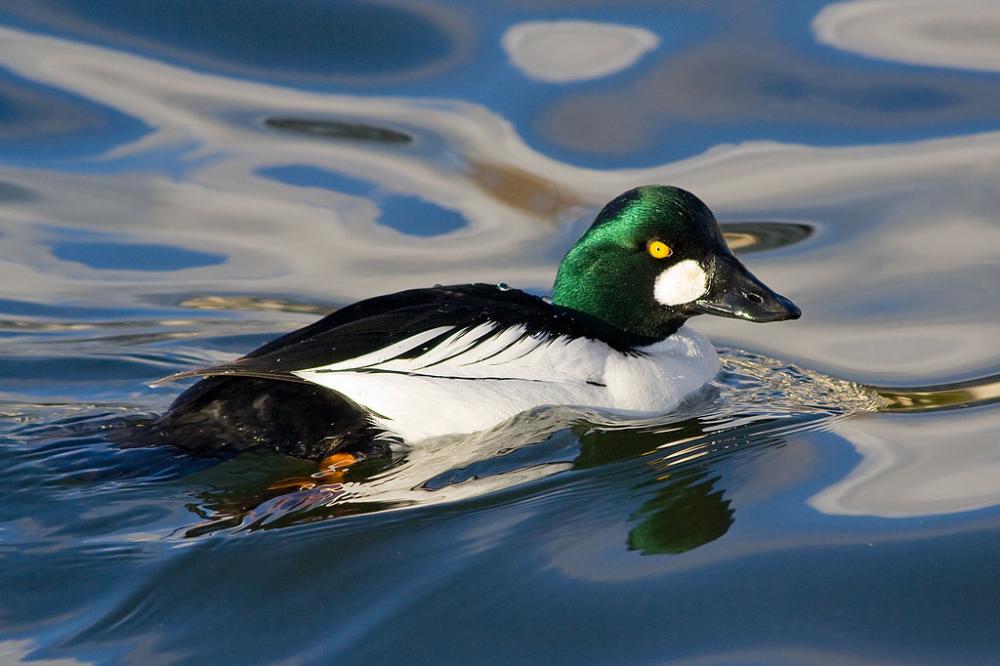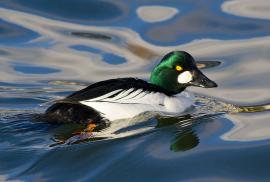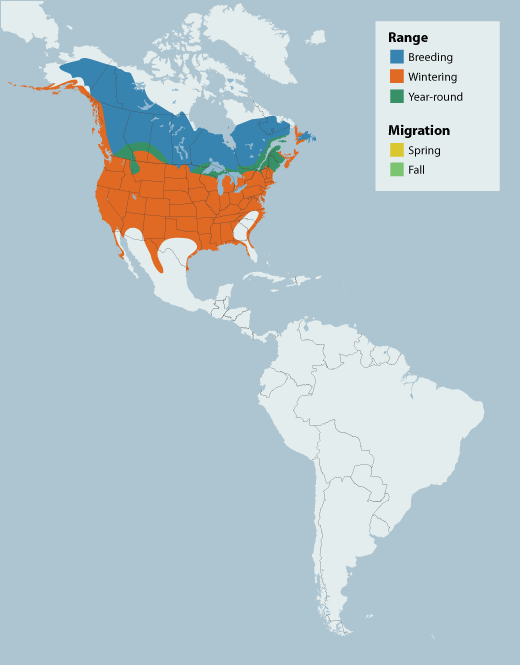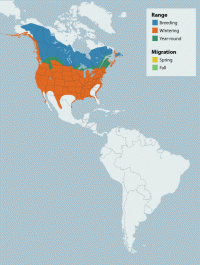Guide to Boreal Birds
This is an in-depth boreal species profile.
What is this?
This species is one of more than 30 birds selected for in-depth profiles. Find out why and see all selected boreal birds »
Overview
Among Common Goldeneyes pair formation begins in midwinter, and until then the two sexes often form separate flocks. Indeed, males winter farther north than do the females. During its courtship display, the male stretches his head forward along the water and then snaps it rapidly upward over his back, bill pointed skyward, while uttering a shrill, two-noted call. Then he swings his orange feet forward, sending up a small shower in front of him. The wings of this species produce a loud whistling sound in flight, easily identified even when the birds cannot be seen; hunters call this species the "Whistler." Goldeneyes can dive to depths of 20 feet (6 meters) or more, but generally limit themselves to about 10 feet (3 meters). In winter, goldeneyes feed mainly on mollusks; in summer, their diet shifts to aquatic plants and insects.
Considering that the combined summer and winter ranges of this species essentially blanket the U.S. and Canada, the Common Goldeneye, known to hunters as the "Whistler," is surprisingly unfamiliar to the general public. This is a shame because it is a gorgeous bird that, if better known, could galvanize greater interest in preserving the boreal forest environment in which it breeds.
Description
16-20" (41-51 cm). Male has white body; black back; black-appearing (actually glossy greenish) head; and large, round white spot in front of eye. Eye bright yellow. Female grayish, with warm brown head, white neck ring, and dark bill. Both sexes have a distinctive puffy head shape and a large white wing patch, conspicuous in flight. See Barrow's Goldeneye.
Voice
Courtship call of male a high-pitched jeee-ep! Females utter a low quack.
Nesting
8-12 pale green eggs in a mass of down in a natural tree cavity, up to 608 (18 m) above the ground.
Habitat
The Common Goldeneye nests in tree cavities in mature forests - and, in northern areas, in rock cavities - near wetlands, lakes, and rivers. In most areas, it prefers small, clear lakes with relatively little emergent vegetation. Preferred lakes also have high invertebrate populations and few or no fish, which may compete for food or, if large enough (e.g., northern pike), eat the ducklings. Birds that migrate through the interior stop briefly to feed on large lakes and rivers. Most winter in shallow coastal bays, estuaries, and harbors but some winter inland on large, ice-free lakes and rivers.
Range/Migration
This species is particularly hardy and often the last waterfowl species to leave the breeding grounds and the first to return. Migration peaks occur in November and March/April. The species migrates in small, loose flocks, concentrating at suitable stopover points, especially in spring when these are limited. River valleys tend to funnel inland migrants to some extent. All populations are migratory, even where the species occurs year-round. Individuals may migrate only as far as necessary to find open water. The winter range is contiguous with the breeding range except in south-coastal Alaska and extends from the Alaska Peninsula along the Pacific coast to southern British Columbia, then across southern Canada and the lower 48 (except inland southern areas and south Florida) into coastal and lowland northern Mexico. Adult males tend to remain farther north than adult females, which in turn remain north of juveniles. The species also breeds across northern Eurasia and winters south to the Mediterranean, Caspian Sea, and Japan.
Breeding
The Common Goldeneye is almost exclusively a boreal breeder. In North America, its breeding range extends from west-central Alaska across the Canadian forests and prairies to the Maritimes and south to the northern tier of states. As mentioned above, this duck is a cavity nester. Inexperienced and unsuccessful females typically form small flocks and prospect for suitable nest cavities the summer before breeding. Typical of ducks, goldeneyes then pair on the winter grounds. The males perform a spectacular and complex courtship display including 14 distinct behaviors in winter and spring; usually about four males display to each female. These behaviors include throwing the head back, kicking the water, and calling. Interested females respond with up to three of these behaviors. Once paired, the male tends the female, driving away other males, until she departs for her preselected nest site with him in tow (and often with unsuccessful males following). Elaborate territorial displays and defenses are undertaken by the male for the duration of the northward migration. The male guards his mate while she lays 7 to 10 eggs, indicating that other males may attempt to copulate with her, but abandons her soon after clutch completion. Usually only one egg is laid every other day and, at least during the early stages of laying, the pair spends considerable time away from the nest. Females of this and other cavity-nesting ducks often "dump" their eggs in other females' unattended nests, especially in areas where nest sites are scarce. Female goldeneyes may wind up raising young of several species. If egg dumping occurs early enough, the female goldeneye can adjust her own egg output to avoid winding up with too many eggs to raise. Since females often nest near their birthplaces, related birds often are parasitizing one another, so the genetic cost to the hostess may be reduced. Further, host females likely are also dumping their own eggs. The incubation period is about 30 days; the precocial young jump from the nest within two days of hatching and follow their "mother" to the water, which may be as much as two miles away. Females guard the young but do not feed them, and abandon them before they can fly. Broods often converge after abandonment or as a result of separation from their "mothers," which often, especially on small lakes, is the result of territorial disputes between females. The limited amount of parental care in ducks minimizes the energetic cost of raising others' young. Only about a third of young survive to flying age.
Diet/Feeding Behavior
This species forages in fairly shallow water along shorelines. It usually dives, using the feet and tail for propulsion and steering, but occasionally dabbles, especially when very young. Winter flocks and duckling broods often dive simultaneously. Typical dives are about 25 seconds long, 20 seconds apart, and less than 4 meters (13 ft) to the bottom. Aquatic crustaceans (crabs, amphipods, shrimp, isopods, and barnacles), insects (caddisfly larvae; water boatmen; dragonfly, damselfly, and mayfly nymphs; and beetles), seeds and other plant material (pondweeds, spatterdock, and bulrush), mollusks, and fish and their eggs, in that order, comprise the diet.
References
Andersson, M., and M.O.G. Eriksson. 1982. Nest parasitism in goldeneyesBucephala clangula: some evolutionary aspects. Amer. Nat. 120:1-16.
Bellrose, F.C. 1980. Ducks, geese, and swans of North America. Rev. ed. Stackpole Books, Harrisburg, PA.
Dane, B., and W.G. van der Kloot. 1964. An analysis of the display of the Goldeneye duck (Bucephala clangula (L.)). Behaviour 22:282-328.
Eadie, J.M., and G. Gauthier. 1985. Prospecting for nest sites by cavity-nesting ducks of the genus Bucephala. Condor 87:528-534.
Eadie, J.M., M.L. Mallory, and H.G. Lumsden. 1995. Common Goldeneye (Bucephala clangula). In The Birds of North America, No. 170 (A. Poole and F. Gill, Eds.). Philadelphia: The Academy of Natural Sciences; Washington, D.C.: The American Ornithologists' Union.
Gooders, J., and T. Boyer. 1986. Ducks of North America and the Northern Hemisphere. Facts on File, New York.
Mallory, M.L., D.K. McNicol, and P.J. Weatherhead. 1994. Habitat quality and reproductive effort of Common Goldeneyes nesting near Sudbury, Canada. J. Wildl. Manage. 58:552-560.
Mallory, M.L., P.J. Weatherhead, D.K. McNicol, and M.E. Wayland. 1993. Nest site selection by Common Goldeneyes in response to habitat features influenced by acid precipitation. Ornis Scand. 24:59-64.
National Audubon Society. 2002. The Christmas Bird Count Historical Results [Online]. http://www.audubon.org/bird/cbc.
Pöysä, H. 1992. Variation in parental care of Common Goldeneye (Bucephala clangula) females. Behaviour 123:247-260.
Sauer, J. R., J. E. Hines, and J. Fallon. 2003. The North American Breeding Bird Survey, Results and Analysis 1966-2002, Version 2003.1, USGS Patuxent Wildlife Research Center, Laurel, MD.
Savard, J.-P.L., and J.M. Eadie. 1989. Survival and breeding philopatry in Barrow's and Common Goldeneyes. Condor 91:198-203.
Wayland, M., and D.K. McNicol. 1994. Movements and survival of Common Goldeneye broods near Sudbury, Ontario, Canada. Can. J. Zool. 72:1252-1259.
Zicus, M.C., and S.K. Hennes. 1989. Nest prospecting by Common Goldeneyes. Condor 91:807-812.
Zicus, M.C., S.K. Hennes, and M.R. Riggs. 1995. Common Goldeneye nest attendance patterns. Condor 97:461-472.
Credits
Birding content provided by National Wildlife Federation/eNature, with support from Ducks Unlimited/The Pew Charitable Trusts.





